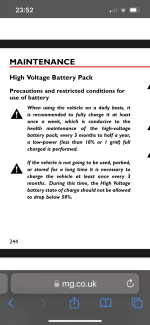Rolfe
Moderator
- Joined
- Apr 10, 2023
- Messages
- 7,644
- Reaction score
- 8,490
- Points
- 2,562
- Location
- West Linton, Scotland
- Driving
- MG4 SE SR
I understand the MG5 can charge at up to 80kW. Using the 3pin plug I am drawing around 10Amps. Not sure what this means kW wise?
Using a “wall box”, would this get me closer to the 80kW? I have looked around at them and they mostly seam to be limited to about 7kW. There does appear to be a lot to choose from.
Lots of new words and terms to get my head around.
Maybe I should be asking these questions on a different conversation thread?
The 80 Kw thing is the best you might expect to get from a public DC charger, when you're trying to "fill up" in a hurry on the road. It's not applicable to AC charging, which is what you're doing at home.
If you're getting the answers you need here, it's all good. If not, try a search of the MG5 forum for appropriate threads.
